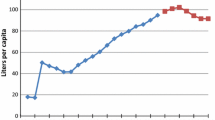Abstract
This paper describes the life-cycle alcohol consumption patterns of Italian households by decomposing gender, cohort, age and time effects and estimates the importance of demographic characteristics using a double-hurdle model. The application is based on ISTAT households expenditure survey for the period 1997–2002 organized in cohorts. As expected, cohort and age effects are significant in both participation and consumptions. The significance of gender and geographic differences suggests important policy implications.
Similar content being viewed by others
References
Amemiya T (1984) Tobit models: a survey. J Econ 84:3–61
Angulo MA, Gil JM, Gracia A (2001) The demand for alcoholic beverages in Spain. Agric Econ 26:71–83
Atkinson AB, Gomulka J, Stern NH (1984) Household expenditure on tobacco 1970–1980: evidence from the Family Expenditure Survey. ESRC Programme on Taxation, Incentives, and the Distribution of Income, Discussion Paper 57
Attanasio O (1998) A cohort analysis of saving behavior by U.S. households. J Hum Resour 33:575–609
Blaylock JR, Blisard WN (1993) Wine consumption by US men. Appl Econ 24:645–651
Blisard WN (2001) Income and food expenditures decomposed by cohort, age and time effects. Technical Bulletin n. 1896, United States Department of Agriculture
Blundell RW, Meghir C (1987) Bivariate alternatives to the Tobit model. J Econ 33:179–200
Browning M (1987) Eating, drinking, smoking, and testing the lifecycle hypothesis. Quart J Econ 102: 329–346
Browning M, Deaton A, Irish M (1985) A profitable approach to labor supply and commodity demands over the life-cycle. Econometrica 53:503–543
Chaloupka FJ, Grossman M, Saffer H (2002) The effects of price on alcohol consumption and alcohol-related problems. Alcohol Res Health 26:22–34
Cragg J (1971) Some statistical models for limited dependent variables with application to the demand for durable goods. Econometrica 39:829–844
Deaton A (1985) Panel data from time series of cross sections. J Econ 30:109–126
Deaton A (1997) The analysis of household surveys: a microeconomic approach to development policy. Johns Hopkins University Press, Baltimore
Deaton A, Irish M (1984) Statistical models for zero expenditures in household budgets. J of Public Econ 23:59–80
Deaton A, Paxson C (1994) Intertemporal choice and inequality. J Politi Econ 102:437–467
Deaton A, Paxson C (2000) Growth and saving among individuals and households. Rev Econ Stat 82: 212–225
Dee TS (2001) Alcohol abuse and economic conditions: evidence from repeated cross-sections individual-level data. Health Econ 10:257–270
Evandrou M, Falkingham J (2004) Cigarette smoking and drinking behaviour in Northern Ireland 1986–2002: a cohort analysis. Report for the Department of Health, Social Services and Public Safety, Northern Ireland
Garcia J, Labeaga JM (1996) Alternative approaches to modelling zero expenditure: an application to Spanish demand for tobacco. Oxf Bull Econ Stat 58:489–506
Gibson JK, Scobie GM (2001) Household saving behaviour in New Zealand: a cohort analysis. Treasury Working Paper 01/19, The Treasury, Wellington
Greenfield TK, Kerr WC (2003) Tracking alcohol consumption over Time. Alcohol Res Health 27:30–38
Heckman J (1979) Sample selection bias as a specification error. Econometrica 47:153–161
Jappelli T (1999) The age-wealth profile and the life-cycle hypothesis: a cohort analysis with a time series of cross-sections of Italian households. Rev Income Wealth 45:57–75
Jones AM (1989) A double-hurdle model of cigarette consumption. J Appl Econ 4:23–39
Jones AM (1992) A note on computation of the double-hurdle model with dependence with an application to tobacco expenditure. Bull Econ Res 44:67–74
Kapteyn A, Alessie R, Lusardi A (2003) Explaining the wealth holdings of different cohorts: productivity growth and social security. Eur Econ Rev 49:1361–1381
Keelan C, Henchion M, Newman C (2005) Eating out on the celtic tiger. Working paper presented at the 97th Seminar of the European Agricultural Economist Association, Reading, 21–22 April 2005
Kerr WC, Greenfield TK, Bond J, Ye Y, Rehm J (2004) Age, period and cohort influences on beer, wine and spirits consumption trends in the US National Alcohol Surveys. Addiction 99:1111–1120
Labeaga JM (1999) A double-hurdle rational addiction model with heterogeneity: estimating the demand for tobacco. J Econ 93:49–72
Maddala GS (1983) Limited-dependent and qualitative variables in econometrics. Cambridge University Press, Cambridge
McKenzie D (2002) Disentangling age, cohort and time effects in the additive model. Working Papers 02009, Stanford University, Department of Economics
Moffatt PG (2005) Hurdle models of loan default. J Oper Res Soc 56:1063–1071
Newman C, Henchion M, Matthews A (2003) A double-hurdle model of Irish household expenditure on prepared meals. Appl Econ 35:1053–1061
Pierani P, Tiezzi S (2004) Addiction and the demand for alcoholic beverages: evidence from Italian data. University of Siena Mimeo
Pudney S (1989) Modelling individual choice: the econometrics of corners, kinks and holes. Basil Blackwell, New York
Ruhm CJ (1995) Economic conditions and alcohol problems. J Health Econ 14:583–603
Scafato E, Russo R (2004) La donna e l’alcol. Tendenze nei consumi e strategie di intervento. Annali dell’Istituto Superiore di Sanità 40:1–14
Tobin J (1958) Estimation of relationships for limited dependent variables. Econometrica 26:24–36
Vuong QH (1989) Likelihood ratio test for model selection and non-nested hypotheses. Econometrica 57:307–333
Yen ST (1994) Cross-section estimation of U.S. demand for alcoholic beverages. Appl Econ 26:381–392
Yen ST (2005a) A multivariate sample-selection model: estimating cigarette and alcohol demands with zero observations. Am J Agricl Econ 87:453–466
Yen ST (2005b) Zero observations and gender differences in cigarette consumption. Appl Econ 37: 1839–1849
Yen ST, Jensen HH (1996) Determinants of household expenditures on alcohol. J Consum Affairs 30:48–67
Author information
Authors and Affiliations
Corresponding author
Rights and permissions
About this article
Cite this article
Aristei, D., Perali, F. & Pieroni, L. Cohort, age and time effects in alcohol consumption by Italian households: a double-hurdle approach. Empir Econ 35, 29–61 (2008). https://doi.org/10.1007/s00181-007-0142-5
Received:
Accepted:
Published:
Issue Date:
DOI: https://doi.org/10.1007/s00181-007-0142-5




